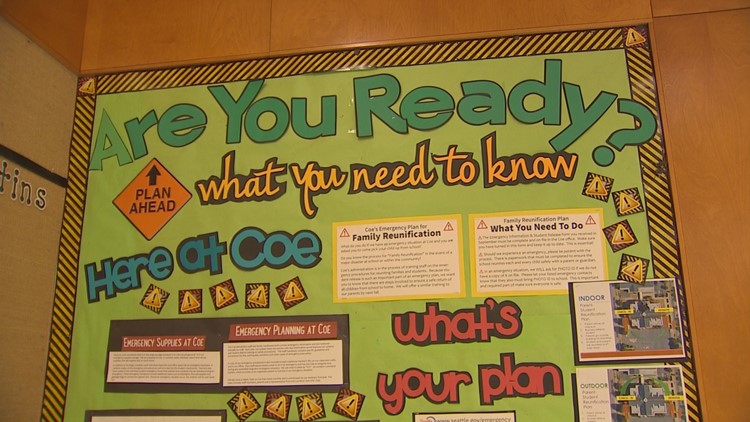If children are not with mom and dad when a disaster hits, chances are they will be at school. So what are schools doing to make sure kids are ready and safe?
Once a month, throughout the year, schools in Washington state conduct safety drills, like for earthquakes or evacuations. State law requires every public school to have an emergency management plan.
For example, at Seattle's Coe Elementary School, each classroom keeps a backpack with supplies, like first aid supplies, cups for drinking water, and activities for kids.
The backpack also includes a handbook with emergency information for every student, like food allergies and medical conditions. That handbook also lays out when the school's incident command system kicks in, assigning teachers and staff to specific jobs to help the community, in case first responders are slow to arrive.
"We as a building need to facilitate emergency management," said assistant principal Lindsey Backstrom. "Anything from nutrition, to search and rescue, student supervision, and public information officer."
The school's emergency plan includes a detailed reunification process, including maps, verification forms, and locations for parents to pick up their kids.
"Parents would check in at the front of the school which is the front of our building, verify their identity, a runner would go to where that child is in the building," said Backstrom.
A big part of disaster readiness is preparing the child. In the last year, the Red Cross has brought the Pillowcase Project to more than 4,000 students in the state of Washington. Using pillowcases they provide to students, Americorp members, like Maggie Shepherd and Ellie Huizenga, come into the classroom to teach kids to put together their personal portable preparedness kits, including items like water, non-perishable food, a small radio, and a comfort item the child can choose on her own.
The Red Cross believes kids can play a motivating role for the family.
"When you have kids coming home and they're so excited about building their disaster kit," said Allison DeDonato, regional preparedness manager for the Red Cross, "and they're excited about finding a meeting location, they're going to make sure their parents do it."
But as prepared as students and staff may be in western Washington, the school buildings themselves can be woefully vulnerable based on what's below them.

Corina Forson, Department of Natural Resources chief hazard geologist, laid out two maps showing the seismic safety of Washington state schools.
"This is based on shaking intensity, from different fault scenarios, liquefaction, and what we know about the soils beneath the schools," Forson said.
The maps show that many schools in western Washington are at high risk.
"A lot of schools, school districts are red, that means high risk. Orange is moderate. Yellow is low," she said.
The DNR is asking for money to study the costs to retrofit the structures. Until then, it's up to schools to be as prepared as possible.
While schools require parents to provide emergency contact information, it's up to parents to ask and learn about their school's emergency plan. The goal is for when disaster strikes, we have a pre-programmed response.
"It's like a muscle. You want to work it out. You want to be familiar," said Backstrom.
According to OSPI, the state law that requires disaster plans for public schools does not cover private schools.
A spokesperson for Seattle Public Schools said in a statement: “Schools are currently asked to plan for three days of supplies. The Nutrition Services Department sends out supplies at the beginning of the year, which are rotated out at the end of school. Most schools have additional classroom supplies for at least one day. We can see in the future adding to more food and water supplies based on lessons from the Cascadia Drill. Parents are informed of the appropriate parts of the school's emergency plan but it would be hard to "require" a certain awareness level.”
The Red Cross has tips for families with financial hardship on how to build a disaster preparedness kit on a budget. To request a Pillowcase Project presentation at your school, contact the Red Cross on their website.
Resources:
How to prepare for different types of emergencies
Mobile apps for preparedness and disaster info
Join KING 5’s Disaster Preparedness Facebook group and learn how you and your community can get ready for when disaster strikes.



